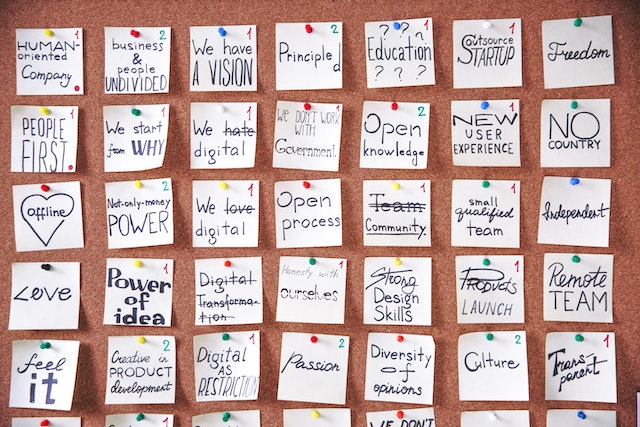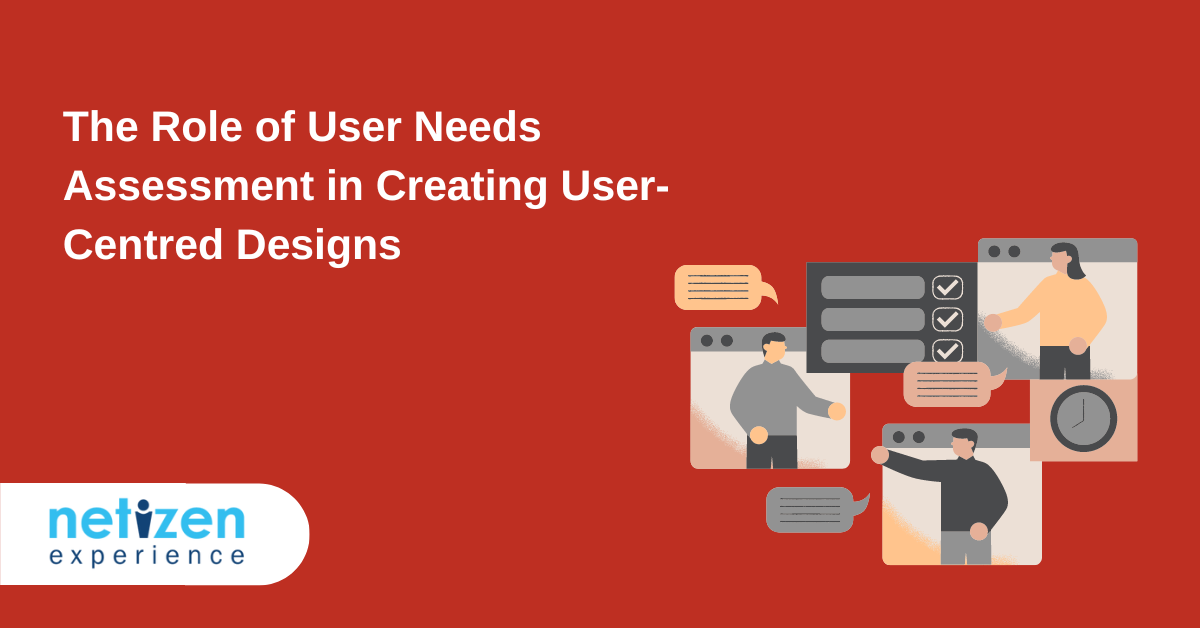Creating user-centred design is vital in UX/UI development because it ensures that the end product is intuitive, and meets the needs and expectations of the target audience.
In this Article
In practice, a user-centred design approach revolves around iteratively gathering feedback and insights from users throughout the design process to inform design decisions.
And thus, increase customer satisfaction, loyalty, and engagement.
One critical component central to delivering effective user-centred design (UX design) is a user needs assessment.
In this article, we shall delve into user needs assessments and the role they play in gathering information about users’ needs, preferences, and pain points.
We shall also unpack how they help UX designers to inform design decisions and help devise designs that meet the user’s expectations and ultimately increase their satisfaction.
What is a user needs assessment?
User needs assessment is the process of gathering and analysing data to comprehend the end-user’s requirements, preferences, and pain points. Subsequently, this information is utilised to inform design decisions and produce user-centred designs that meet the user’s expectations.
In practice, a user requirements assessment can be conducted throughout the design process, from concept to launch. In fact, assessment of user requirements can take many forms, including surveys, focus groups, interviews, card sorting, and A/B testing. The choice of method depends on the project’s objectives, timeline, and budget.
For instance, a user needs assessment is particularly useful when redesigning an existing product or developing a new one. In such cases, user needs analysis helps identify the gaps in the current product, understand what the users want from the product, and design features that meet their needs.
What is user-centred design?
User-centred design is a design approach that places the preferences, needs, and pain points of the end-users (and their context) at the centre of the design process.
It involves gathering data on the above needs through a user needs assessment and using that data to inform design decisions, in the most effective and efficient way possible.
Fundamentally, the ultimate goal of user-centred design is to create a product that meets the user’s expectations, increases their satisfaction, and provides a positive user experience.
Benefits of conducting a user need assessment
- Increased user satisfaction: UX designers improve user satisfaction and outcomes by employing insights derived from a user needs assessment into how users interact with the product in order to create products best suited to them.
- Reduced development cost: Creating items that work for the users’ purposes lessens the necessity of making expensive UX alterations and modifications in future. Thus, reducing the overall cost of development in the long term.
- Increased market success: UX designers can maximise their market potential and differentiate themselves from other businesses by leveraging user needs assessment data to formulate goods and services that respond to users’ requirements.
- Improved user engagement: User needs assessments can enable UX designers to design products that better foster user engagement. Additionally, it can help encourage some users to become more involved in and committed to the product by letting them participate in the design process.
- Better alignment with business objectives: When UX designers comprehend user needs and preferences, they can create products that align with the broader business strategy and objectives.
- Reduced risk of product failure: By conducting user needs assessments, designers can identify potential issues early on and design products that are more likely to succeed in the market.
- Improved brand reputation: By creating products that are user-centred and meet user needs, companies can build a positive brand reputation and increase customer loyalty.
Methods of needs assessment
Here are some key methods typically employed to conduct a user needs assessment:
Surveys
Surveys are a common method of user needs assessment that involves asking a set of standardised questions to a large group of people. They can be conducted online, by mail, or in person and can be used to collect both quantitative and qualitative data on user needs, preferences, and behaviours.

Photo by Antoni Shkraba
Focus groups
Focus groups usually involve bringing together a small group of people to discuss a specific topic in depth. They are typically moderated by a trained facilitator and can be used to collect qualitative data on user needs, preferences, and behaviours.
Interviews
Interviews involve one-on-one conversations between a researcher and a user. They can be conducted in person or over the phone and can be used to collect qualitative data on user needs, preferences, and behaviours.
Card Sorting
Card sorting involves asking users to organise a set of cards (with each containing a piece of content or functionality) into groups that make sense to them. The results can provide insights into how users expect to find and navigate through information, which can inform the design.

Photo by Polina Zimmerman
A/B testing
A/B testing is essentially a method of comparing two different versions of a product or service to determine which one performs better. Users are randomly assigned to either Version A or Version B, and their behaviour is measured and analysed to determine which version is more effective at achieving the desired outcome.

How to conduct a user needs assessment to create user-centred designs?
To effectively conduct a user needs assessment to create user-centred designs, one can take the following steps:
Step 1: Identify the purpose and goals of the user needs assessment:
During this step, determine the objectives of the user needs assessment and the questions you intend to address.
Step 2: Identify the target user group:
Define the target user group, which could be current or potential users of the product or service.
Step 3: Choose the appropriate user needs assessment method:
During this step, ensure to choose the most appropriate user needs assessment method based on the project’s objectives, timeline, and budget.
Step 4: Recruit participants/Respondent recruitment:
Identify and recruit respondents who meet the criteria for the target user group and are willing to participate in the evaluation.
Step 5: Conduct the user needs assessment:
Administer the evaluation method, such as surveys, interviews, or focus groups, and collect data on user needs, preferences, and pain points.
Step 6: Analyse and interpret the data:
During this step, extensively analyse and interpret the user data collected during the user needs assessment to identify patterns, trends, and key insights.
Step 7: Develop user personas:
In this step, build user personas based on the data collected during the assessment, which represent typical users and their needs, goals, and behaviour.
Step 8: Use the findings to inform design decisions:
Apply the knowledge gained from the user needs assessment to inform design decisions and create a user-centred design that precisely meets the needs of the target users.
Best practices for effective user needs assessment to create user-centred designs.
Best practices for user needs assessment ensure that the design process is focused on meeting the needs of the target audience.
In essence, best practices help to establish a framework for the user-centred design process that is based on research, data, and user feedback, whilst taking into account the needs and preferences of the target audience.
Some of the best practices we recommend to achieve effective user need assessments when creating user-centred design are:
- Engage users as early as possible in the design process to ensure that their requirements are considered throughout the process.
- Avoid leading questions: Ask users neutral queries that do not elicit a specific response. This ensures that the responses are objective and precise.
- Select appropriate evaluation methods: Select the method or combination of methods that best fit the project’s objectives, timeline, and budget. Consider employing a combination of techniques to obtain a deeper understanding of user requirements.
- Recruit a sample of representative users: Ensure that the user group is representative of the intended user group and that the sample size is sufficient to yield insightful results.
- Use open-ended questions: Utilise open-ended queries to elicit detailed and sincere user feedback that can inform design decisions.
- Provide a relaxed and comfortable environment: Create an environment conducive to comfort and relaxation during user requirements assessment to encourage users’ candour and openness.
- Conduct ongoing assessments: Conduct ongoing user requirements assessments throughout the UX/UI design process to ensure that the design satisfies the changing needs of the intended audience.
- Collaborate with stakeholders: Include all relevant stakeholders, including designers, developers, marketers, and product managers, in the user requirements assessment process.
- Use data visualisation tools: Use data visualisation tools to help make sense of the data acquired during the assessment and to clearly and concisely present the findings to stakeholders.
- Validate findings: Validate the user needs assessment findings by verifying design decisions with users throughout the design process. This ensures that the final design meets the requirements of the intended audience.
By leveraging the above best practices, UX designers can ensure that they’re using proven methods and techniques to gather user feedback and analyse and interpret this feedback effectively.
Thus, ensuring that the design process is collaborative and inclusive for all stakeholders involved in the user-centred design process.
Read and explore more on UX Design insights.
Conclusion
In summary, user needs assessments play a critical role in creating user-centred designs. By iteratively engaging with users to gather their feedback, UX designers can create products that meet the needs of the target audience and can be adopted and deployed effectively.
As we also noted, this process may help to improve product usability, functionality, and overall user experience, leading to augmented customer satisfaction and loyalty.
Overall, conducting a user needs assessment is an essential step in creating user-centred designs that meet the needs and preferences of target users.
By doing this, you can ensure that your designs are truly user-centered. This will not only lead to a more successful product but also a more positive user experience. For companies that may not have the internal resources to conduct a comprehensive user needs assessment, partnering with a UI/UX design agency can be a valuable solution. Agencies have the expertise and experience to guide you through this crucial stage of the design process.
By religiously following the few steps outlined in this article, designers can gather valuable insights into user needs and preferences, which can inform design decisions and improve product satisfaction, market success, and brand reputation.
From card sorting to A/B testing, there are various methods to choose from depending on the project goals, timeline, and budget.
In conclusion, by investing in user needs assessment, designers can reduce the risk of product failure and gain a competitive edge in the market.
For companies without the internal resources, partnering with a UI/UX design agency or utilizing our user research services can be a valuable solution to guide you through this crucial design stage.
Reach out to us at Netizen Experience for user needs assessment for your next project!

